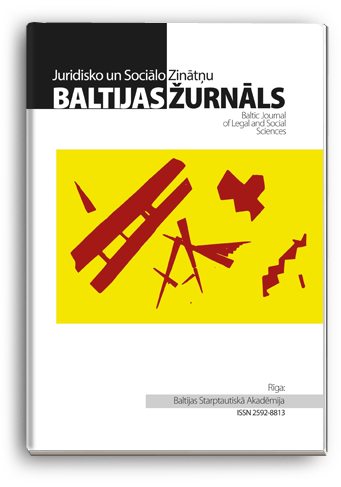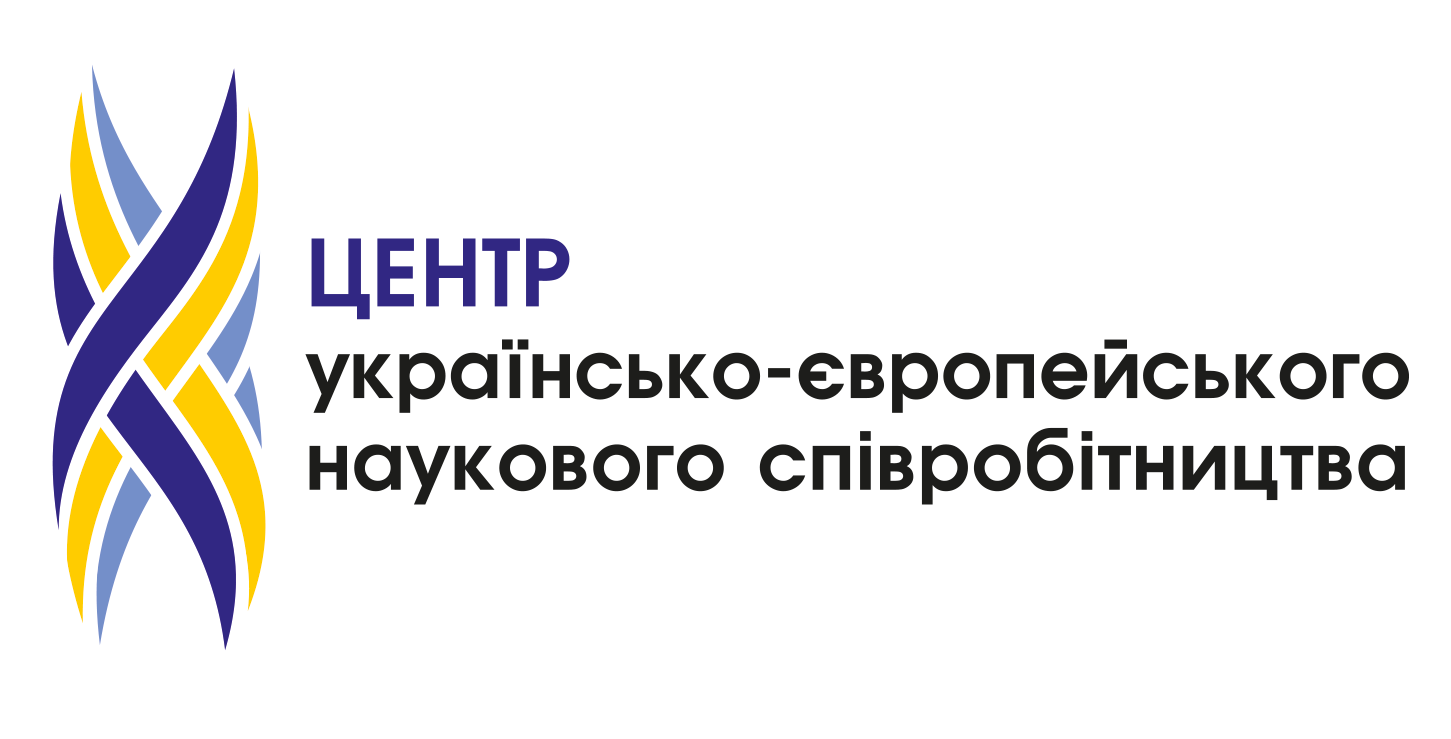

Dear authors!
We kindly invite you to publish your articles in the foreign scientific journal
Baltic Journal of Legal and Social Sciences
Fill an application form
Download the newsletter
“Baltic Journal of Legal and Social Sciences” accepts articles devoted to the most relevant issues, which contain the outcomes of in-depth research, novelty, and justification of scientific conclusions meeting the purpose of the article, which have never been published and correspond to the subject area: law, education/pedagogy, psychology, culture and art, journalism, management and administration, historyand archeology, philosophy, political science, sociology.

Founder: Baltic International Academy (BIA), bsa.edu.lv.
Publisher: Publishing House “Baltija Publishing”, baltijapublishing.lv.
Periodicity: 4 times a year.
Publication language: English.
The journal is indexed in the international scientometric databases Index Copernicus and ERIH PLUS.
A scientific article published in the scientic journal “Baltic Journal of Legal and Social Sciences” is considered a release in a periodical scientifical publication of a member country of the Organization for Economic Co-operation and Development and the European Union in accordance with para. 2.2 of the Order of the Ministry of Education and Science «On the Issuance of the Results of Dessertations on Obtaining the Degree of Doctor and Candidate of Sciences» No. 1220 dated September 23, 2019 (for obtaining the degree of Candidate and Doctor of Sciences).
To publish an article in the journal “Baltic Journal of Legal and Social Science” Issue No. 4, 2025 you must send an e-mail to the editorial office at bjlss@cuesc.org.ua on or before November 28, 2025 with the following materials:
- the article drawn up according to the requirements specified by the editors. The articles, which do not meet the requirements, can be rejected;
- the application form for the author filled at link;
- a payment receipt*.
*The requisites for paying a publication fee are sent only after successful review of the article. The author will be informed on the results of the review process within 3-4 days from the day of receipt of the materials by the editors.
COST OF PUBLICATION:
The cost of publishing a scientific article in the journal “Baltic Journal of Legal and Social Sciences” is 1 100 UAH. It costs 900 UAH for the members of the Center for Ukrainian and European Scientific Cooperation (information on how to become a member of CUESC is available at link). The publication fee covers expenses associated with reviewing, article proofreading and editing, journal mocking-up and publication of its electronic version.
If desired, an author can order a printed copy of the journal. The cost of a printed copy is UAH 800, which is paid in addition to the publication fee.
The electronic version of the journal will be released on the official website on January 28, 2026 at this link.
Authors who ordered a printed copy will receive it before February 28, 2026.
PROHIBITION TO REFER TO THE AGGRESSOR STATE’S SCHOLARLY PAPERS:
It is prohibited citing and including in the reference list russian-language contributions published in any country, incl. papers written in other languages but published in russia and belarus.
SECTIONS:
- Law
- Education/pedagogy
- Psychology
- Culture and art
- Journalism
- Management and administration
- Historyand archeology
- Philosophy
- Political science
- Sociology
GENERAL REQUIREMENTS FOR THE SCIENTIFIC ARTICLE:
- The article should present the author’s own opinion on the stated topic.
- The article should contain ideas characterized by a high level of generalization and scientific novelty.
- The title of the article, abstract and key words are given in English. The last name and first name are transliterated according to the current transliteration requirements of the author’s country.
- The article file must contain:
1. Information about authors (the last name and first name, scientific degree, academic rank, position, affiliation, city/town, country).
2. Title of the article, abstract and key words in English.
3. Text of the article with the subtitles, filled out by borrowings and references to sources.
4. References.
ТЕCHNICAL ARRANGEMENT:
1. Papers: 30.000–40.000 characters with spaces (also including abstracts, references, bibliography, tables, diagrams, and footnotes).
2. The margins – 2 cm; the paragraph – 0.75 cm; the indent before and after paragraph – 0; line spacing – 1.5.
3. The font – Times New Roman; skittles 14.
4. Arrangement of the article text:
- The title of the article (center alignment, capital bold letters).
- The first name and last name of the author (center alignment, normal letters, bold, italic).
- Affiliation, city/town, country, ORCID (center alignment, normal letters, italic).
- Abstract – 1 paragraph from 100 to 150 volume, normal font.
- Key words – 6–8 words of phrases by the article’s topic, normal font.
- The main text of the article, normal font. The subtitles are highlighted in bold. References – normal font.
5. You should clearly differentiate the dash (–) and the hyphen (-).
6. It is forbidden to expand or to condense the intervals between letters.
7. It is forbidden to make the paragraphs by tabulations or by multiple spaces.
8. The only one space is used between words (it is forbidden to expand the words by several spaces).
9. The quotation marks of the format « » can be used only.
10. The non-breaking space (Ctrl + Shift + Space) is used between the initial letters and the last name.
11. In addition to the text, the full JPEG and JPG images elements are allowed only.
12. The graphic elements, made in graphic editors with high-quality details, are allowed to use.
13. It is forbidden to use scanned drawings/drafts made with a pencil or pen by hand.
14. The excessive use of tables is forbidden, a small volume of tables are allowed only.
15. The file format for sending to the editors can be .DOC or .DOCX only.
SТRUCTURE OF THE SCIENTIFIC ARTICLE:
The title of the article should briefly inform its content and contain no more than 13 words.
Abstract (100–150 words) should be clear and informative (with no secondary phrases, general information), meaningful (to present the main content of the article). It should contain an introductory sentence, a brief description of the methods of conducting research (1-2 sentences). There should be a description of the main results and concise conclusions or prospects for further research. The abstract must be clear and without familiarizing with the main content of the article.
Key words: 6–8 words /phrases reflecting the specifics of the topic without duplicating words from the article’s title.
The text of the article should contain the introduction, the main part and the conclusions.
“Introduction” should contain a description of research of the problems in the world scientific literature and the purpose of work.
The main text. The research tasks should be formulated. The purpose and tasks should be interconnected and reveal of the article’s topic. The materials and methods of research, research results and their discussion should be presented.
Materials and methods of research are formed in the way so the research can be reproduced according to the description provided. The common methods require no explanations.
The results and discussion: the main research material outlined with full justification of the scientific results obtained. The results should be presented in a logical sequence in the text, tables and figures. It is not necessary to duplicate and repeat the data of tables and figures in the text. Their comparison can be mentioned only. When summarizing quantitative data, it is necessary to indicate not only relative (for example, percent), but also absolute values, and the specific statistical methods applied for their analysis should be mentioned.
The discussion. This part contains the interpretation of results only, without their iteration. It is necessary to select new and important aspects of the conducted research, to analyze the possible mechanisms or interpretation of these data and to compare them with the data of other researchers, if it is possible. The discussion could include well-grounded recommendations for practice and possible perspectives for applying the results in the future studies.
“Conclusion”. The results of solving the problem indicated in the title and purpose of the article are presented here.
“References”. All sources from the references should be quoted in the text of the article; otherwise, the corresponding element should be deleted. The references to sources used should be mentioned in parentheses, where the author’s name, the year of publication, the page to which you refer in the text should be mentioned. For example: Jones S. stated, “Students often had difficulty using APA style” (Jones, 1998, p. 199). The references should be listed. If the article sourced has the digital object identifier, DOI (http://doi.org/index.html), it should be necessarily mentioned.
References should be completed under International Standard Bibliographic Description, APA (http://www.apastyle.org/). The title of sources in Ukrainian should be translated in English, their transliterated titles should be mentioned in parentheses*. For example: Bernatska, Zh. (2020). Administratyvno-hospodarske pravo yak pravova osnova formuvannia ta realizatsii ekonomichnoi funktsii ukrainskoi derzhavy [Administrative and commercial law as a legal basis for the formation and implementation of the economic function of the ukrainian state]. Administratyvne pravo i protses, 3(30), 5–16. doi: 10.17721/2227-796X.2020.3.01 [in Ukrainian].
*Websites for transliteration from: Ukrainian.
ACADEMIC INTEGRITY:
The Editorial Board guarantees high-quality anonymous peer-review of articles and their check for plagiarism using StrikePlagiarism.com by the Polish company Plagiat.pl.
REVIEW PROCESS:
All materials submitted to the editors and corresponding to the topic are reviewed before release with the involvement of at least two experts. Reviewing is carried out by one of the members of the editorial board, who is a recognized expert in the field of knowledge on the subject of the presented work. The objective reviewers carefully evaluate the quality of the submitted article, including using their personal criteria. The reviewers check the manuscripts to justify the chosen research methodology and procedures. In addition, they are able to detect unethical actions or plagiarism. If the reviewer has comments on the article, it can be returned to the author for revision.
The editorial board of the journal reserves the right to reject articles that do not meet the requirements and topics of the journal.
EXAMPLE OF THE ARTICLE EXECUTION:
HARMONIZATION OF ADMINISTRATIVE AND LEGAL REGULATION OF STATE GOVERNANCE OF ECONOMIC ACTIVITY IN UKRAINE: SOME LANDMARKS
Svitlana Bevz,
Doctor of Law, Associate Professor,
Associate Professor at the Department of Economic and
Administrative Law of the National Technical University of Ukraine
“Igor Sikorsky Kyiv Polytechnic Institute” (Kyiv, Ukraine)
ORCID ID: 0000-0003-1331-3930
Email
Abstract. The author analyzes scientific opinions about the harmonization of administrative regulation of public administration in the economic activity of Ukraine… (100–150 слів).
Key words: Іnternational treaty, soft law, adaptation of legislation, Europeanization of administrative law, reform of administrative legislation.
Текст статті … (Pukhtetska, 2012: 78).
References:
- Pukhtetska, A.A. (2012). Poniattia ta pryntsypy yevropeiskoho administratyvnoho prava [Concepts and principles of European administrative law]. Naukovi zapysky NaUKMA. Yurydychni nauky, 129, 78–81 [in Ukrainian].
REPRESENTATION IN UKRAINE:
 Center for Ukrainian and European Scientific Cooperation
Center for Ukrainian and European Scientific Cooperation
Coordinator of foreign scientific journal:
Liashchova Anastasiia Oleksandrivna
Tel.: +38 (095) 653 40 42
E-mail: bjlss@cuesc.org.ua
Website: cuesc.org.ua/zhurnali/bjlss
Official website of the journal: baltijapublishing.lv/index.php/bjlss









